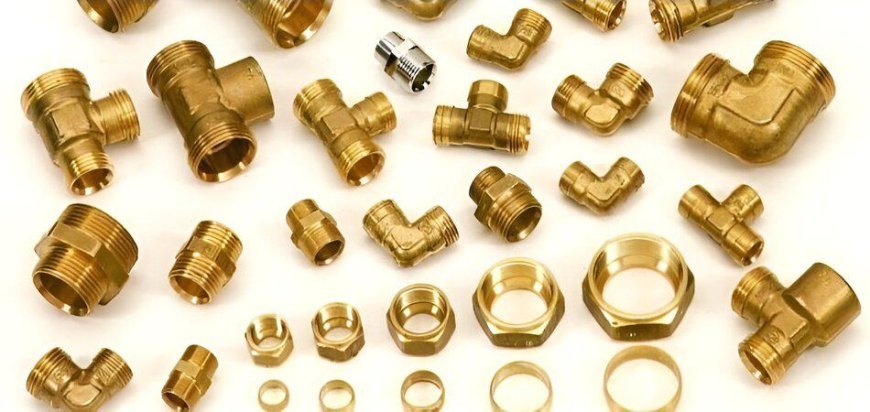Brass Fittings: Strength Meets Flexibility

In the world of plumbing, construction, HVAC, and industrial manufacturing, fittings are the unsung heroes that make reliable systems possible. Among the wide variety of materials used for fittings, brass has stood the test of time as one of the most trusted and versatile options. Its unique blend of strength, flexibility, and corrosion resistance gives brass fittings a distinct edge over other materials. But what makes brass such a reliable choice? How does it outperform other metals, and where does it truly shine?
In this comprehensive exploration of brass fittings, we’ll delve into their history, composition, types, benefits, applications, and future potential. By the end, you’ll understand why brass fittings are often considered the gold standard in mechanical and plumbing systems—quite literally and figuratively.
What Are Brass Fittings?
Brass fittings are components used to connect, terminate, control flow, and change the direction of piping in many different industries. They are made primarily from brass, an alloy composed of copper and zinc. Sometimes, small amounts of other elements such as lead, aluminum, or tin are added to enhance specific properties like machinability or corrosion resistance.
These fittings come in a wide variety of shapes and sizes, including:
-
Elbows
-
Tees
-
Couplings
-
Nipples
-
Adapters
-
Bushings
-
Compression fittings
-
Flare fittings
-
Barb fittings
Each type serves a specific purpose and is selected based on the requirements of the application.
A Brief History of Brass
Brass has been used for centuries, dating back to at least 500 BCE. Its origins can be traced to early metallurgy where copper was alloyed with zinc ore to produce a stronger and more resilient metal. Over time, the use of brass became widespread in tools, weapons, art, and plumbing systems, thanks to its desirable properties.
During the Roman era, brass was used in everything from coins to decorative items. Its resistance to corrosion and malleability made it ideal for intricate designs and long-lasting structures. As civilization advanced, so did our understanding and refinement of brass alloys, eventually leading to their integration into modern piping and mechanical systems.
Why Brass? Key Material Properties
Brass possesses a unique combination of physical and chemical properties that make it particularly suitable for fittings. Let’s break down what makes it so special:
1. Strength and Durability
Brass fittings are exceptionally strong, able to withstand high pressures and temperatures without deforming. This makes them ideal for systems that require long-term performance and reliability, such as central heating, compressed air systems, and industrial pipelines.
2. Corrosion Resistance
Unlike iron or steel, brass does not rust. It forms a natural protective patina that resists corrosion from water, air, and many chemicals. This is especially valuable in plumbing, where the integrity of the system must be maintained over decades.
3. Malleability and Machinability
Brass is easier to shape and machine than most metals, allowing for precision manufacturing and a variety of complex fitting shapes. This quality also facilitates tight seals, reducing the risk of leaks in plumbing systems.
4. Thermal and Electrical Conductivity
Although not as conductive as pure copper, brass still retains significant thermal and electrical conductivity, making it a preferred choice in HVAC systems and low-voltage electrical applications.
5. Aesthetic Appeal
With its warm, golden hue, brass also holds aesthetic appeal, often used in exposed plumbing and decorative hardware.
Types of Brass Fittings and Their Uses
There are several kinds of brass fittings tailored to specific functions. Here's a breakdown of the most common ones:
Elbows
Used to change the direction of flow in piping systems, typically available in 45° or 90° angles. Ideal for tight spaces and corner installations.
Tees
Shaped like the letter “T”, these fittings split or combine flows. They're common in water distribution systems where one source must supply multiple outlets.
Couplings and Unions
Used to join two pipes together. Couplings are permanent, while unions allow for easy disconnection, often used in applications where maintenance is expected.
Compression Fittings
These create tight seals using compression rings or ferrules. They're often used in water supply lines and gas systems due to their leak-proof performance.
Flare Fittings
Designed for high-pressure applications, these use a flared tube end and a nut to provide a secure seal, popular in gas and refrigeration lines.
Barbed Fittings
These have ridges or barbs that grip flexible tubing. They're commonly found in low-pressure systems like irrigation or fuel lines.
Applications Across Industries
Brass fittings have made their mark in a wide range of industries due to their versatility:
1. Plumbing
In both residential and commercial settings, brass is a favorite for water and waste systems. It resists corrosion from water, provides a secure connection, and ensures longevity.
2. HVAC Systems
Heating, ventilation, and air conditioning systems benefit from brass fittings’ ability to handle temperature changes and pressure without degrading.
3. Automotive
In the automotive sector, brass is used in fuel line fittings, brake lines, and radiator connections due to its ability to handle vibration and corrosion.
4. Marine
Brass’s corrosion resistance, particularly to saltwater, makes it valuable in shipbuilding and marine equipment.
5. Industrial Manufacturing
From pneumatic controls to chemical processing, brass fittings are essential in systems that demand durability and reliability.
Advantages Over Other Materials
How does brass stack up against other commonly used fitting materials like plastic, stainless steel, or copper?
| Material | Advantages | Disadvantages |
|---|---|---|
| Brass | Corrosion-resistant, strong, ductile, long lifespan | Can be more expensive than plastic |
| Plastic (PVC/CPVC) | Lightweight, inexpensive, corrosion-proof | Less durable, limited pressure/temperature range |
| Stainless Steel | Very strong and corrosion-resistant | Expensive, harder to machine |
| Copper | High thermal/electrical conductivity | Softer, can corrode in certain environments |
Brass strikes a balance between performance and cost, offering durability without the high price tag of stainless steel or the limited strength of plastic.
Environmental and Safety Considerations
Modern brass fittings are increasingly made to comply with stringent environmental and health standards. For instance, low-lead brass has become the norm in potable water systems to ensure compliance with regulations such as the U.S. Safe Drinking Water Act.
Recyclability is another point in favor of brass. As a metal alloy, brass can be melted down and reused indefinitely without significant loss of quality. This makes it a sustainable choice in today’s environmentally-conscious construction industry.
Maintenance and Lifespan
Brass fittings are known for their low maintenance. Once installed correctly, they can last 40 to 70 years, depending on environmental conditions and usage. Occasionally, joints may need tightening or re-sealing, but brass typically doesn’t require frequent replacement like some plastic counterparts.
Corrosion can occur under extreme conditions, particularly in acidic or highly chlorinated water. However, in most standard applications, this is not a concern. Regular inspections and maintenance of the surrounding system are usually sufficient to ensure brass fittings continue to perform well over decades.
Innovations and The Future of Brass Fittings
As with many traditional materials, brass fittings are evolving with the times. Some current and upcoming innovations include:
Smart Fittings
These are fittings integrated with sensors that monitor pressure, temperature, or flow rate. This technology is already appearing in smart home and industrial IoT (Internet of Things) systems.
Alloy Optimization
New formulas for brass alloys are being explored to reduce lead content without sacrificing performance, ensuring even higher safety for drinking water and medical applications.
Eco-Manufacturing
Manufacturers are adopting greener production techniques, such as low-emission casting, water recycling in machining, and the use of renewable energy sources.
3D Printing and Rapid Prototyping
Brass is now being used in metal 3D printing for prototyping complex fittings, enabling custom solutions and reducing development time for new systems.
Final Thoughts: The Balance of Strength and Flexibility
Brass fittings represent a harmonious blend of strength and flexibility—two qualities often at odds in engineering. They provide robust, long-lasting connections while allowing enough give to accommodate pressure changes, temperature fluctuations, and mechanical stress.
Their enduring popularity across plumbing, automotive, industrial, and marine sectors is a testament to their reliability. Whether you’re building a skyscraper, maintaining a vintage car, or installing a garden irrigation system, brass fittings are a trusted component in the infrastructure of daily life.
In a world increasingly focused on durability, efficiency, and sustainability, brass continues to shine—not just for its golden color, but for the gold standard it represents in the world of fittings.
What's Your Reaction?




























































